

Thanks to their hardiness and the low growing requirements they need, Hypericum are the perfect plants for beginner gardeners, or those who have a difficult garden to bloom.
Overall Hypericum key facts :
Botanical name – Hypericum sp.
Family – Hypericaceae, Clusiaceae
Type – herbaceous perennial, shrub
Height – 1 to 5 feet (30 cm to 150 cm),
Exposure – sun to part sun
Hardiness – hardy to semi-hardy
Foliage: deciduous to evergreen – Flowering: summer
Common name – Saint John’s wort
The Saint John’s wort botanical genus is so extensive, that it can’t be classified into a single type of plant: some are herbaceous perennials, others are sub-shrubs and yet others are shrubs in their own right.
This diversity begets a vast choice of sizes and shapes with various bearings.
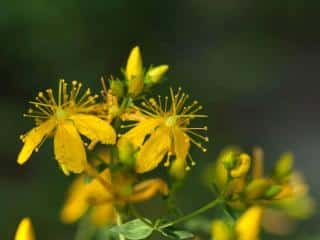 In general, Hypericum all have in common a summer blooming that’s very characteristic and instantly recognizable. It’s impossible to walk by these gold-colored flowers with prominent stamens, blissfully feeding hordes of bees and bumblebees.
In general, Hypericum all have in common a summer blooming that’s very characteristic and instantly recognizable. It’s impossible to walk by these gold-colored flowers with prominent stamens, blissfully feeding hordes of bees and bumblebees.
Leaves, however, may be quite different from one to the next. But they all have a lanceloate shape that’s more or less narrow. Depending on the species, foliage is either evergreen, semi-evergreen, or deciduous.
All Hypericum don’t have the same hardiness to the cold. Though the vast majority of them is quite hardy and copes easily with 5°F (-15°C), some are a bit more vulnerable and will have trouble when the thermometer drops below 32°F (0°C).
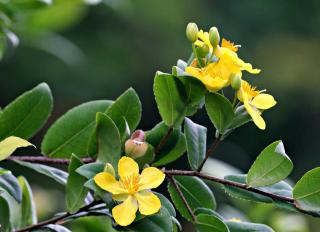 Regarding the terrain, larger species appreciate fertile soil, it matches their needs better. All require some degree of moisture in the ground, which is usually easily provided with a little bit of the right mulch. Luckily, smaller Saint John’s wort specimens aren’t as vulnerable to lack of water, these are excellent for rocky terrain and low-water gardens.
Regarding the terrain, larger species appreciate fertile soil, it matches their needs better. All require some degree of moisture in the ground, which is usually easily provided with a little bit of the right mulch. Luckily, smaller Saint John’s wort specimens aren’t as vulnerable to lack of water, these are excellent for rocky terrain and low-water gardens.
In addition, apart from their great diversity, another noteworthy advantage of Hypericum is their tolerance to limestone, which is a type of soil that has the reputation of being difficult to flower.
Among the many available species and varieties of saint John’s wort, we’ll mention here:
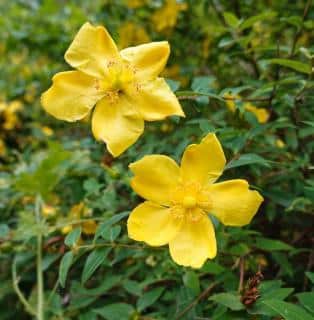 Possibly the most famous variety, this shrubby saint John’s wort has evergreen foliage. It’s hardy and will settle in basically anywhere in the garden, whatever the soil type and exposure.
Possibly the most famous variety, this shrubby saint John’s wort has evergreen foliage. It’s hardy and will settle in basically anywhere in the garden, whatever the soil type and exposure.
With a size that reaches 4 feet tall and 3 feet wide (1.25 m x 1 m), it’s one of the Hypericum that are large.
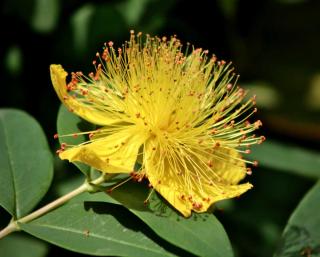 Smaller than its ‘Hidcote’ cousin, this species won’t exceed 16 inches/40 cm tall and wide. It’s an excellent plant to cover the ground with large flowers.
Smaller than its ‘Hidcote’ cousin, this species won’t exceed 16 inches/40 cm tall and wide. It’s an excellent plant to cover the ground with large flowers.
Hardy and without any particular requirements regarding exposure and soil, it’s great to embellish any garden, no matter how difficult.
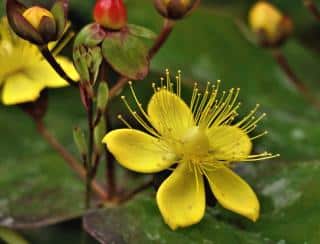 This Saint John’s wort has deciduous foliage, though it may remain semi-evergreen: this depends on how harsh the cold is. Its leaves grow on stems that have a beautiful purple bark, more or less intense depending on whether it’s recent or older growth. Another appealing feature is that its flowers give way to bright red berries that turn black over time.
This Saint John’s wort has deciduous foliage, though it may remain semi-evergreen: this depends on how harsh the cold is. Its leaves grow on stems that have a beautiful purple bark, more or less intense depending on whether it’s recent or older growth. Another appealing feature is that its flowers give way to bright red berries that turn black over time.
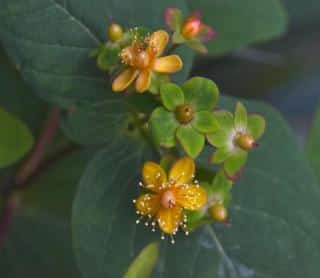 Very similar to the androsaemum species, this Hypericum is, however, a little bit taller.
Very similar to the androsaemum species, this Hypericum is, however, a little bit taller.
Though all the other growing parameters are the same as for other Saint John’s wort, i.e. reasonable hardiness and no influence of exposure, it does have one extra requirement: it prefers cool soil.
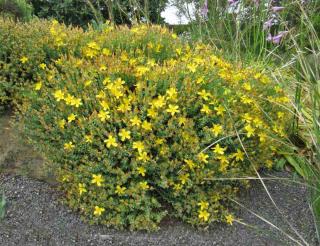 The great diversity within the botanical genus Hypericum allows for many different landscaping uses: edges, rocky terrain, growing beds with shrubs or flowers. It’s even possible to grow these in pots.
The great diversity within the botanical genus Hypericum allows for many different landscaping uses: edges, rocky terrain, growing beds with shrubs or flowers. It’s even possible to grow these in pots.
Some, such as Hypericum calycinum, are excellent to cover and stabilize mounds, or populate shaded forest underbrush.